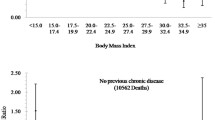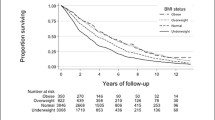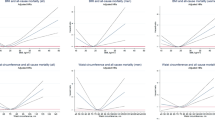Abstract
Objectives
To comprehensively evaluate the association between BMI and death risk in people aged 65 years and over in Shenzhen, China, and suggest the optimal range of body mass index (BMI) for the older adults.
Design
A prospective cohort study.
Setting
A population-based study of elderly adults in Shenzhen, China.
Participants
359044 Shenzhen Healthy Ageing Research participants aged 65 and over with 4682 deaths during a mean of 1.5 years of follow-up were included in this analysis.
Measures
Hazard ratio of all-cause and cause specific mortality risks associated with BMI categories. The association between BMI and all-cause and cause specific mortality were independently estimated by Cox regression model.
Results
Regardless of gender, BMI of 24–29.9 kg/m2 was a protective factor for death in all ages, while BMI above 30 kg/m2 was still a protective factor for older adults under 70 years old. Regardless of age, BMI at 24–25.9 kg/m2 was associated with lower mortality in men, while BMI at 26–27.9 kg/m2 was associated with lower mortality in women. For the older adults without chronic diseases, BMI at 24–25.9 kg/m2 was also significantly associated with lower mortality. In the analysis of BMI and cause of death, we also found that BMI of 24–25.9 kg/m2 was significantly associated with the lower mortality from cardiovascular disease, cancer, chronic respiratory disease and digestive system disease in China.
Conclusion
BMI in the range of 24–25.9 kg/m2 may be protective for mortality in Chinese older adults. Additional more large-scale, multicenter and long-term follow-up studies are needed to confirm these findings in different populations.



Similar content being viewed by others
References
Fang EF, Scheibye-Knudsen M, Jahn HJ et al. A research agenda for aging in China in the 21st century. AGEING RES REV 2015;24(Pt B):197–205. doi:https://doi.org/10.1016/j.arr.2015.08.003
Zeng Y. Towards Deeper Research and Better Policy for Healthy Aging —Using the Unique Data of Chinese Longitudinal Healthy Longevity Survey. China Economic J 2012;5(2–3):131–149. doi:https://doi.org/10.1080/17538963.2013.764677
Hana Y, Heb Y, Lyuacd J et al. Aging in China: perspectives on public health. Global Health Journal 2020
Wang LX, Fan MY, Yu CQ et al. Association between body mass index and both total and cause-specific mortality in China: findings from data through the China Kadoorie Biobank. Zhonghua Liu Xing Bing Xue Za Zhi 2017;38(2):205–211. doi:https://doi.org/10.3760/cma.j.issn.0254-6450.2017.02.014
Bhaskaran K, Dos-Santos-Silva I, Leon DA et al. Association of BMI with overall and cause-specific mortality: a population-based cohort study of 3.6 million adults in the UK. Lancet Diabetes Endocrinol 2018;6(12):944–953. doi:https://doi.org/10.1016/S2213-8587(18)30288-2
Global BMC, Di Angelantonio E, Bhupathiraju S et al. Body-mass index and all-cause mortality: individual-participant-data meta-analysis of 239 prospective studies in four continents. LANCET 2016;388(10046):776–786. doi:https://doi.org/10.1016/S0140-6736(16)30175-1
Cardoso AS, Xavier MO, Dos SCC et al. Body mass index and mortality among community-dwelling elderly of Southern Brazil. PREV MED 2020;139:106173. doi:https://doi.org/10.1016/j.ypmed.2020.106173
Obesity: preventing and managing the global epidemic. Report of a WHO consultation. Obesity: preventing and managing the global epidemic. Report of a WHO consultation. World Health Organ Tech Rep Ser 2000;894:1–253
Berrington DGA, Hartge P, Cerhan JR et al. Body-mass index and mortality among 1.46 million white adults. N Engl J Med 2010;363(23):2211–2219. doi:https://doi.org/10.1056/NEJMoa1000367
Oreopoulos A, Kalantar-Zadeh K, Sharma AM, Fonarow GC. The obesity paradox in the elderly: potential mechanisms and clinical implications. CLIN GERIATR MED 2009;25(4):643–659. doi:https://doi.org/10.1016/j.cger.2009.07.005
Zhou BF. Predictive values of body mass index and waist circumference for risk factors of certain related diseases in Chinese adults—study on optimal cut-off points of body mass index and waist circumference in Chinese adults. BIOMED ENVIRON SCI 2002;15(1):83–96
Lyu SQ, Yang YM, Zhu J et al. Association between body mass index and mortality in atrial fibrillation patients with and without diabetes mellitus: Insights from a multicenter registry study in China. Nutr Metab Cardiovasc Dis 2020;30(12):2242–2251. doi:https://doi.org/10.1016/j.numecd.2020.07.028
Wang L, Du X, Dong JZ et al. Body mass index and all-cause mortality in patients with atrial fibrillation: insights from the China atrial fibrillation registry study. CLIN RES CARDIOL 2019;108(12):1371–1380. doi:https://doi.org/10.1007/s00392-019-01473-3
Feng X, Zhang C, Jiang L et al. Body mass index and mortality in patients with severe coronary artery diseases: A cohort study from China. Nutr Metab Cardiovasc Dis 2021;31(2):448–454. doi:https://doi.org/10.1016/j.numecd.2020.09.011
Wu CY, Chou YC, Huang N et al. Association of body mass index with all-cause and cardiovascular disease mortality in the elderly. PLOS ONE 2014;9(7):e102589. doi:https://doi.org/10.1371/journal.pone.0102589
Wang YF, Tang Z, Guo J et al. BMI and BMI Changes to All-cause Mortality among the Elderly in Beijing: a 20-year Cohort Study. BIOMED ENVIRON SCI 2017;30(2):79–87. doi:https://doi.org/10.3967/bes2017.011
He Y, Lam TH, Jiang B et al. Changes in BMI before and during economic development and subsequent risk of cardiovascular disease and total mortality: a 35-year follow-up study in China. DIABETES CARE 2014;37(9):2540–2547. doi:https://doi.org/10.2337/dc14-0243
Lv YB, Liu S, Yin ZX et al. Associations of Body Mass Index and Waist Circumference with 3-Year All-Cause Mortality Among the Oldest Old: Evidence from a Chinese Community-Based Prospective Cohort Study. J AM MED DIR ASSOC 2018;19(8):672–678. doi:https://doi.org/10.1016/j.jamda.2018.03.015
Hu H, Wang J, Han X et al. BMI, Waist Circumference and All-Cause Mortality in a Middle-Aged and Elderly Chinese Population. J NUTR HEALTH AGING 2018;22(8):975–981. doi:https://doi.org/10.1007/s12603-018-1047-z
Liu S, Wu X, Lopez AD et al. An integrated national mortality surveillance system for death registration and mortality surveillance, China. Bull World Health Organ 2016;94(1):46–57. doi:https://doi.org/10.2471/BLT.15.153148
Ni W, Yuan X, Zhang J et al. Factors associated with treatment and control of hypertension among elderly adults in Shenzhen, China: a large-scale cross-sectional study. BMJ OPEN 2021;11(8):e44892. doi:https://doi.org/10.1136/bmjopen-2020-044892
Chinese Diabetes Society. Chinese guideline for the prevention and treatment of type 2 diabetes mellitus (2017 edition). Chinese Journal of Diabetes Mellitus 2018;10(1):4–67. doi:https://doi.org/10.3760/cma.j.issn.1674-5809.2018.01.003
Joint Committee For Guideline Revision. 2016 Chinese guidelines for the management of dyslipidemia in adults. J GERIATR CARDIOL 2018;15(1):1–29. doi:https://doi.org/10.11909/j.issn.1671-5411.2018.01.011
Klenk J, Rapp K, Ulmer H et al. Changes of body mass index in relation to mortality: results of a cohort of 42,099 adults. PLOS ONE 2014;9(1):e84817. doi:https://doi.org/10.1371/journal.pone.0084817
National Health Commission Of The People’S Republic Of China. Health management technical protocol of aged. In. Vol. 2022, 2015; http://www.nhc.gov.cn/ewebeditor/uploadfile/2016/01/20160128143208616.pdf.
Bender R, Jöckel KH, Trautner C et al. Effect of age on excess mortality in obesity. JAMA 1999;281(16):1498–1504. doi:https://doi.org/10.1001/jama.281.16.1498
Clark K. The effect of age on the association between body-mass index and mortality. J Insur Med 1998;30(1):48–49
Schooling CM, Lam TH, Li ZB et al. Obesity, physical activity, and mortality in a prospective chinese elderly cohort. Arch Intern Med 2006;166(14):1498–1504. doi:https://doi.org/10.1001/archinte.166.14.1498
Bales CW, Buhr GT. Body mass trajectory, energy balance, and weight loss as determinants of health and mortality in older adults. Obes Facts 2009;2(3):171–178. doi:https://doi.org/10.1159/000221008
Mathus-Vliegen EM. Obesity and the elderly. J CLIN GASTROENTEROL 2012;46(7):533–544. doi:https://doi.org/10.1097/MCG.0b013e31825692ce
Goyal A, Nimmakayala KR, Zonszein J. Is there a paradox in obesity? CARDIOL REV 2014;22:163–170. doi:https://doi.org/10.1097/CRD.0000000000000004
Sharma S, Batsis JA, Coutinho T et al. Normal-Weight Central Obesity and Mortality Risk in Older Adults With Coronary Artery Disease. MAYO CLIN PROC 2016;91(3):343–351. doi:https://doi.org/10.1016/j.mayocp.2015.12.007
Bastien M, Poirier P, Lemieux I, Després JP. Overview of epidemiology and contribution of obesity to cardiovascular disease. PROG CARDIOVASC DIS 2014;56(4):369–381. doi:https://doi.org/10.1016/j.pcad.2013.10.016
Colleluori G, Villareal DT. Aging, obesity, sarcopenia and the effect of diet and exercise intervention. EXP GERONTOL 2021;155:111561. doi:https://doi.org/10.1016/j.exger.2021.111561
Oreopoulos A, McAlister FA, Kalantar-Zadeh K et al. The relationship between body mass index, treatment, and mortality in patients with established coronary artery disease: a report from APPROACH. EUR HEART J 2009;30(21):2584–2592. doi:https://doi.org/10.1093/eurheartj/ehp288
Doehner W, Clark A, Anker SD. The obesity paradox: weighing the benefit. EUR HEART J 2010;31(2):146–148. doi:https://doi.org/10.1093/eurheartj/ehp339
Whitlock G, Lewington S, Sherliker P et al. Body-mass index and cause-specific mortality in 900 000 adults: collaborative analyses of 57 prospective studies. LANCET 2009;373(9669):1083–1096. doi:https://doi.org/10.1016/S0140-6736(09)60318-4
Gu D, Kelly TN, Wu X et al. Mortality attributable to smoking in China. N Engl J Med 2009;360(2):150–159. doi:https://doi.org/10.1056/NEJMsa0802902
Cheng FW, Gao X, Mitchell DC et al. Body mass index and all-cause mortality among older adults. Obesity (Silver Spring) 2016;24(10):2232–2239. doi:https://doi.org/10.1002/oby.21612
Acknowledgments
We are grateful to all the volunteers for participating in the present study, and to all the investigators for their support and hard work during this survey.
Funding
Funding: This study was supported by the Science and Technology Planning Project of Shenzhen City, Guangdong Province, China (Grant No. JCYJ20180703145202065), the Science and Technology Planning Project of Shenzhen City, Guangdong Province, China (Grant No. KCXFZ20201221173600001), Shenzhen Medical Key Discipline Construction Fund, Sanming Project of Medicine in Shenzhen (Grant No. SZSM201811093) and Medical Scientific Research Foundation of Guangdong Province, China (Grant No. A2022082).
Author information
Authors and Affiliations
Contributions
Author contributions: PY and JX conceived the study. WN and WL analyzed the data and wrote the first draft. WN, WL, ZZ, XY, YS, HZ, LW and MZ interpreted the data and critically revised the manuscript for intellectual content. All authors read and approved the final manuscript. Peng Yin and Jian Xu supervised the study, had full access to all data and had the final responsibility in deciding to submit for publication.
Corresponding authors
Ethics declarations
Conflict of interest: All the authors declare no conflict of interest.
Ethical Standards: The study was approved by the Ethics Committee of Shenzhen Center for Chronic Disease Control.
Rights and permissions
About this article
Cite this article
Ni, W., Liu, W., Zhao, Z. et al. Body Mass Index and Mortality in Chinese Older Adults —New Evidence from a Large Prospective Cohort in China. J Nutr Health Aging 26, 628–636 (2022). https://doi.org/10.1007/s12603-022-1813-9
Received:
Accepted:
Published:
Issue Date:
DOI: https://doi.org/10.1007/s12603-022-1813-9




